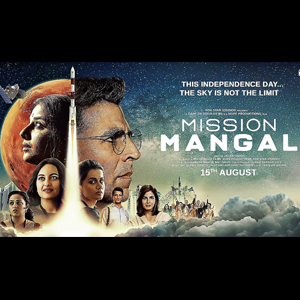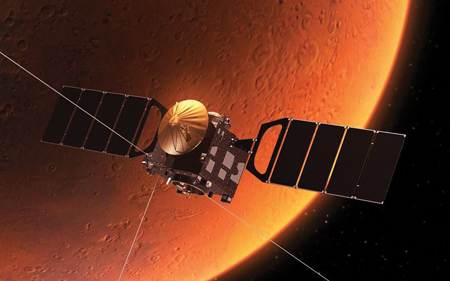Happenings: Reaching for the Moon in Movies

On a day in September of 2014, as dawn was breaking on Mars, Mangalyaan, a.k.a. Mars Orbiter Mission (or M.O.M.), eased into its orbit after traversing 400 million miles in about 300 days, making India the fourth space explorer to reach the red planet (the other players to reach this milestone are based in Russia, the United States and the European Union.) The 3,000-pound orbiter lifted off on the low-cost, Indian-made P.S.L.V. launcher from an insular spaceport in the Bay of Bengal. The feat is all the sweeter considering that India made it to Mars in its maiden attempt.
In August this year, India’s lunar program, Chandrayaan, will make a second bid at soft landing on the Moon’s south pole after its Vikram lander crashed into the regolith, late in the landing process, in 2019. If all goes well, India will gain entry to the elite club that has just three members: U.S., Russia and China. It’s also preparing to lay the groundwork for humans to engage in long-haul space exploration in the future by sending a batch of three astronauts to low Earth orbit on its Gaganyaan capsule as early as 2023. The crew will spend about a week off-Earth.
 How have advances in space exploration inspired filmmakers? Between the sixties and now, Bollywood and its regional counterparts have created only half a dozen motion pictures on the topic—sort of. That’s a very paltry number if you see it in the context of its annual celluloid output of anywhere between 1,500 and 2,000 movies a year. Most new science-fiction films are either about robots or time travel, with romance as a secondary plot.
How have advances in space exploration inspired filmmakers? Between the sixties and now, Bollywood and its regional counterparts have created only half a dozen motion pictures on the topic—sort of. That’s a very paltry number if you see it in the context of its annual celluloid output of anywhere between 1,500 and 2,000 movies a year. Most new science-fiction films are either about robots or time travel, with romance as a secondary plot.
As in the West, where much before men went to space, writers and directors had begun to contemplate such a voyage, so it has been in the East. Chand Par Chadayee (Hindi for Trip to the Moon) had sent folks on a lunar expedition almost a decade before India launched Aryabhata, the 26-sided polyhedron, in 1975. Time passed. Not much happened. A little over 50 years later, in the summer of 2018, along came Tik Tik Tik, a Tamil production. For an industry that has been in the business of cranking out potboilers with song-and-dance extravaganzas for eons, it’s no easy task for it to leapfrog into producing space operas of the caliber of The Expanse, the hit Amazon show. But it has started taking baby steps.
Tik Tik Tik opens with a jagged boulder menacingly hurtling towards Earth. The flaming hot asteroid—not from Cheetos—is on course to strike the eastern coast of India, killing about 40 million people. A blend of Armageddon and Gravity, it doesn’t make any forward-looking predictions about terraforming Venus or settlements on Iapetus; instead, it reflects the nation’s most pressing geopolitical anxieties.

The space division of the Indian Army decides to intercept the space rock and blow it up with a nuclear warhead to alter its path. Although India possesses about 156 of them, the plan is to steal it from an orbital lab run by the enemy. Though it’s never said, it’s evident that it’s operated by the Chinese. The man chosen for the job is part Houdini, part hacker—and he has two sidekicks. The Chinese don’t care that India is about to be pummeled by a cosmic hammer. To them, it’s a golden opportunity—to either rebuild the infrastructure of a battered foe or attack it when it’s down and out. The plot is a stand-in for the cold war between the two Asian neighbors. India is in a space race with China, afraid that its bigger neighbor will pull ahead and acquire superior technologies for space travel.
The science is so bad that it’s, in fact, entertaining. On its way to the research base, hovering 250 miles above Earth, how the NASA-built and Indian-owned Space Shuttle ends up crashing on the Moon, some 238,900 miles from home, flies in the face of logic. Once it’s refueled, it turns around and heads back to its original destination in far less time than it takes for anyone to drive from Brooklyn to the Berkshires, with no warp drive to boot. Training for zero-gravity takes place in an ordinary room in one part of which gravity is turned off and the trainees float around like confetti in the presence of a propeller. As of yet, no technology exists to escape the tug of gravity.
Antariksham 9000 KMPH (Telugu for Space 9000 KMPH), released that winter, revolves around the collision of two Comsats. Mission Mangal (Hindi for Mission Mars), released on India’s Independence Day the following year, is a far more serious endeavor. It’s a tribute to the perseverance of the team of I.S.R.O. (Indian Space Research Organization)—mostly women as in Hidden Figures—behind the launch of Mangalyaan despite budget cuts and engineering obstacles. Thumbing his nose at NASA, the project’s lead manager impresses on his boss the need for India to demonstrate its own know-how.
Indian space science fiction, as a genre, is only emerging. Pumped with rah-rah patriotism, the narratives are, still chiefly, billboards for India’s space program.
Alakananda Mookerjee is a writer based in New York. She is interested in science, science fiction and aerospace.
Enjoyed reading Khabar magazine? Subscribe to Khabar and get a full digital copy of this Indian-American community magazine.
blog comments powered by Disqus










